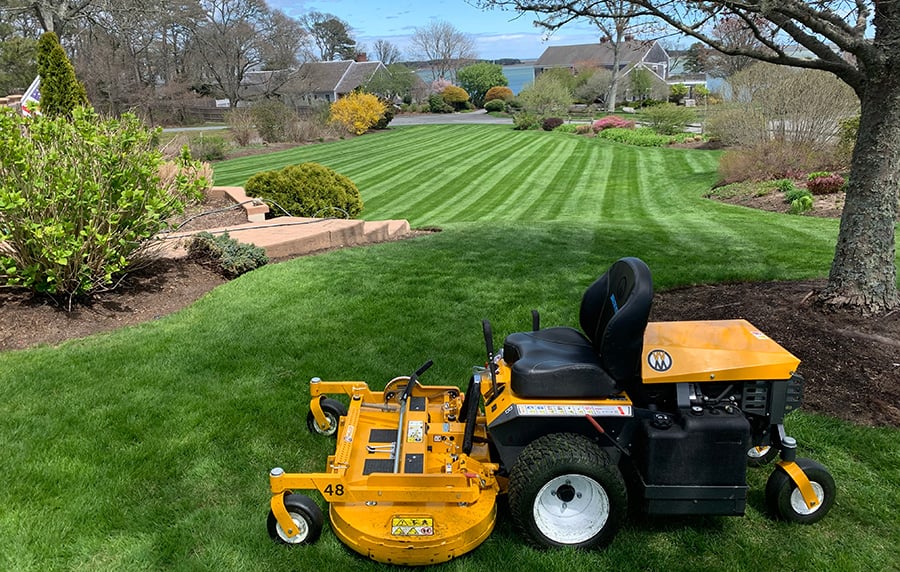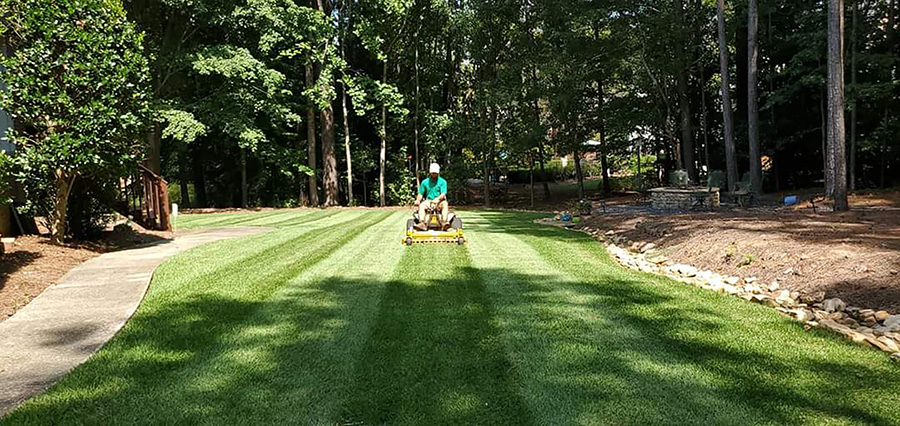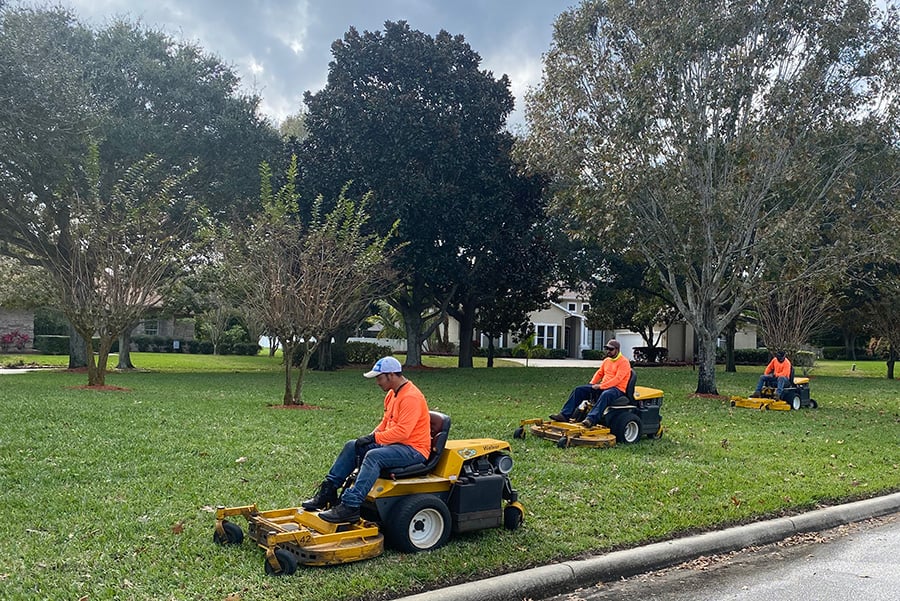There is no mistaking the benefits of grass collection, especially when serving clientele who value an immaculate appearance above all else. But with collection comes extra effort and, in some instances, extra cost. Wouldn’t it be nice to achieve that same clean appearance without having to collect?
With the right mower operated the right way, a growing number of contractors are finding that mulching makes a lot of sense.

Photo courtesy of Birch Landscaping in Harwich, Massachusetts
“The soil is very sandy here on Cape Cod, and leaving the grass clippings
on the lawn really improves that soil,” -Tommy Birch, Birch Landscaping
“Our mulching mowers are the primary machines we use for residential accounts,” says Chris Buisson of Extreme Grounds Management in Merritt Island, Florida. “We use them year-round. Even on thick grass like St. Augustine, our Walkers do an amazing job.”
Buisson has been using Walker Mowers throughout his 36-year career. Today he has 11 in service. Three side-discharge units are reserved for farms and other wide-open properties. A 48-inch GHS is used sparingly to vacuum up the magnolia leaves that fall in winter and are difficult to mulch. The majority of Buisson’s fleet, however, is comprised of mulching mowers. In fact, each of Buisson’s core maintenance crews is equipped with both a 48- and 52-inch mulching mower.
Like Buisson, Matt Lee of Ground Support in Canton, Georgia, selectively uses his GHS mower to vacuum up heavier amounts of leaves. “Other than that, we have strictly become a mulching company,” Lee says.
Tommy Birch of Birch Landscaping in Harwich, Massachusetts, grew up operating a Walker Mower. “My dad bought his first Walker 15 years ago, and I learned how to drive it when I was 12,” Birch tells. That was a GHS model. Last year, Birch took his first stab at mulching.
“The soil is very sandy here on Cape Cod, and leaving the grass clippings on the lawn really improves that soil,” Birch says. “We noticed that irrigated properties didn’t need as much water, and we also worked to regulate the fertilizer on a couple of properties. Mulching is just really beneficial to the health of the lawn, which is exactly what we pride ourselves on.”
Since last year was a testing year, Birch selectively used his new B27i mower with a 48-inch mulching deck. “We typically mulched one week and bagged the next,” he relates. “But some of our properties were mulched all the time. At the end of the season, those were the best-looking lawns we had. I wish we would have mulched more.”
Heading into this season, Birch definitely plans on mulching more. He is adding a second mulching mower to his fleet by converting an existing GHS machine.
“When it’s dry out, the Walker mulching deck turns clippings into nothing,” Birch says. “It gets pretty humid here and the grass holds a lot of moisture, but mulching still works great. The only time mulching won’t work for us is after a rain. But then again, who wants to mow at all after it rains? That’s not what we do since we are focused on quality.”
KEYS TO MAGNIFICENT MULCHING
Like Birch, Caleb James of Fine Lines Wichita in Wichita, Kansas, has been mowing with a Walker B27i equipped with a 48-inch mulching deck.

Photo courtesy of Ground Support in Canton, Georgia
“I like how the deck shreds up the grass and leaves it on the lawn,” James says. “I also like the fact that any fertilizer that was recently put down also stays on the lawn. All of that decomposes and the lawn ends up feeding itself. Our lawns definitely stay greener throughout the year because we mulch.”
For Lee, increased productivity has been the primary benefit of mulching. In addition to his 42-inch GHS mower, Lee owns three Model B’s with 48-inch mulching decks.
“Operating bigger tractors with bigger decks is how we’ve really started to see the productivity improvements,” Lee says. “The 48 is a good fit for the properties we service, which are 1/4- to 1-acre lots. When I was still working by myself and switched from a Model T (GHS) to a Model B (mulching), I was able to grow from 45 accounts to 65. That’s how much more efficient mulching made me.”
Lee has also been surprised by how well the Walker mulches at a lower height. He likes to keep bermudagrass in the 2- to 2.5- inch range.
“With mulching, you have to be out there weekly during the growing season,” Lee explains. “When the temperature starts to crank up, bermudagrass becomes a different animal for a month or two. The secret is taking off that quarter-inch on a weekly mow so you don’t have to worry about having to clean up or double-cut. We structure our contracts so we are able to mow weekly during the heavy-growth season.”
Buisson sets up his contracts to allow for effective mulching, as well.
“When I work with HOAs and commercial properties, I put it in the contract that we will be using mulching mowers,” Buisson says. “We also specify that we will not leave any visible clippings. I have never had a customer complain. My employees are trained to look things over and blow any clippings away or even mow over them a second time if necessary. But this happens very rarely, maybe once during the rainy season.”
Up in Kansas, James says he rarely has to double-cut. But even if he does, it’s not the end of the world. “Then we provide a diamond pattern that looks really nice,” James points out.
To avoid having to double-cut too often, James agrees with Lee that you can’t let a lawn get out of hand.
“There are maybe two weeks a year when my top customers might have to get bagged,” James says. “The rest of the time, mulching works great. I spray Pam cooking oil on the deck to keep grass from building up. Also, having sharp blades is absolutely crucial. I sharpen my blades every other day.”
If mulch clippings ever begin showing up on one of his lawns, Buisson says it is a signal that it’s time to change the blades. As Buisson points out, the art of mulching is part engineering and part operation.
“The Walker tractors have plenty of torque and horsepower to do a great job,” Buisson says. “The rest is up to us. We sharpen or change blades every Monday morning. We also train our employees to check tire pressure every day.”
“There is something to be said for Walker and their mulch decks,” Lee adds. “I’ve put different mulch kits on different mowers and it is just not the same. I feel like the Walker mulch deck was made for us and what we’re trying to do.”

Photo courtesy of Extreme Grounds Management in Merritt Island, Florida
ANOTHER REASON TO LEAVE IT TO MULCHING
Lawn maintenance professionals are finding that a good mulching mower not only provides an advantage when cutting grass, but also cleaning up leaves.
“Even though we use our 48-inch GHS mower to vacuum up magnolia leaves in the winter, we still use mulching mowers on the other leaves we have around here,” Chris Buisson in Florida points out. “My employees love the fact that they don’t have to rake or load leaves onto the trailer.”
Over in Georgia, Matt Lee still uses his Model T GHS when leaf cover is really thick. Most of the time, however, he mulches leaves.
“Sometimes we have to make a couple of passes across a lawn, but we would have to with our GHS mower, as well,” Lee says. “The big difference is not having to haul leaves away. In past years, I’ve hauled 2 tons of leaves to the landfill. I didn’t haul anything last year.”
Up in Kansas, Caleb James uses his mulching mower during leaf season, too. “My customers never even questioned what I was doing because, when I’d left the property, the leaves were gone,” James says. “You’ll never see me wrestling around with loading leaves onto a trailer anymore.”





 Site Search
Site Search



